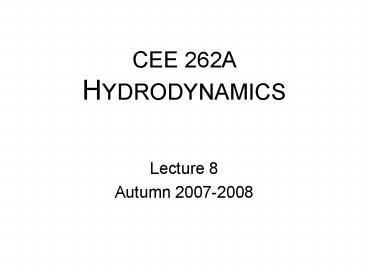CEE 262A HYDRODYNAMICS PowerPoint PPT Presentation
1 / 13
Title: CEE 262A HYDRODYNAMICS
1
CEE 262A HYDRODYNAMICS
Lecture 8 Autumn 2007-2008
2
Navier-Stokes equation with the Boussinesq
approximation
Four eqs., Five unknowns u,v,w,p,r
Now, how does the density vary with time?
(1)
This is a statement of mass conservation in the
Boussinesq approximation, but we already employed
mass conservation when we wrote down the
continuity equation, so equation (1)
is redundant! Solution develop an equation of
state for density.
3
Equation of state
- Thermodynamic state of a pure fluid is given by
two variables - Air Ideal gas law r R T/ p (density is known
if pressure and temperature are known) - Fresh water rr(T,p)
- Salt water theoretically requires three
variables, but in practice 2 are sufficient
Simple definition of salinity dissolved mass of
salts/mass of water - e.g. (ppt) (Ocean varies
from 32 37 ppt, with 35 ppt average) Standard
definition psu (practical salinity scale) (2
42) (Standard equation of state for seawater uses
psu)
4
The internationally recognized equation of state
(UNESCO 1981), which gives r r(T,S) is
nonlinear in T and S, is very complex. Often
we can approximate the equation of state with the
linear equation r/ r0 1 - a(T-T0) b(S S0)
(1) where a 1 X 10-4 K-1, is thermal
expansion coefficient and b 7 X 10-4 psu-1 is
the saline expansivity. A time-evolution
equation for density can be inferred from
the linear equation of state (note this is not a
statement of mass conservation!)
5
Density as a function of temperature for
different salinities (p0)
30
20
S (psu)
Temperature (deg C)
10
0
1020
1030
1010
990
1000
r (kg/m3)
Source Apel Principles of Ocean Physics
6
Conservation of a scalar
Often we require an equation describing the
evolution of scalars such as salinity (S). This
requires us to return to the general form of the
conservation law written for a material volume
Which we can write as
7
Again, we arrive at a general p.d.e. that
describes conservation/evolution of the
concentration (intensity) of some quantity at a
point
While D and C depend on what we are conserving,
the most common surface source is molecular
diffusion, i.e. represents the diffusive flux of
salt . The simplest model for this flux is
Fickian diffusion
Diffusion coefficient a.k.a. diffusivity
8
Why the sign? Down gradient flux gives an
exchange from regions of high concentration to
low concentration
Ocean
River
A really crude model of an estuary
S1 gt S0
S0
Flux of salt
With the inclusion of Fickian diffusion
9
The simplest form with constant (scalar) k k
and no volume sources (D0)
This is exact for molecular diffusion (k10-9
m2/s for NaCl in water) This is often used for
turbulent flows decidedly non exact!
Example Steady state salt balance in an estuary
Total fluxes through any cross-section
River
Ocean
steady state
Estuary cross-section
10
- Assuming that
- A K are constants (not usually true, but)
- The estuary extends to x 8, where S 0
- We can integrate with respect to x1 again
Increase K intrusion increases
Increase Q intrusion decreases
11
Conservation of thermal energy
Based on the first law of thermodynamics
Sources/sinks of heat (Radiation, evaporation,cool
ing)
Diffusion of heat
Heat capacity at constant pressure 4.2 KJ/deg C
kg
Dissipation of mechanical energy (source)
generally small
Divide by r cp and ignore dissipation F
12
What alters the temperature of the oceans,
estuaries, lakes and rivers?
QL Latent heat flux
QS Sensible heat flux
QLW Net longwave radiation
net exchange controlled by water vapor in
atmosphere
evaporation
conduction
Ocean
Qsw Shortwave radiation
13
System of 7 equations in 7 unknowns
(u,v,w,p,r,S,T)

